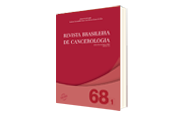Interobserver Agreement in Cytological Diagnosis of Atypical Squamous Cell, Cannot Exclude a High-Grade Lesion and High-Grade Squamous Intraepithelial Lesion in Cervical Lesions
DOI:
https://doi.org/10.32635/2176-9745.RBC.2022v68n1.1338Keywords:
uterine cervical neoplasms, observer variation, Papanicolaou test, squamous intraepithelial lesionsAbstract
Introduction: The Papanicolaou test is an important screening exam for cervical carcinoma. The cytological diagnosis of undetermined atypical squamous cells favoring high-grade lesion (ASC-H) is the category with the least interobserver concurrence. Objective: Evaluate the interobserver concurrence for the ASC-H and high-grade squamous intraepithelial lesions (HSIL) categories at a teaching hospital and to estimate ASC-H’s capacity to predict higher grade lesions. Method: Smears from patients admitted from 2007 to 2015 whose original diagnosis was made by one pathologist, in addition to colposcopy and biopsy, when indicated, made by one gynecologist were collected in the Pathologic Anatomy Service of the hospital. The cytology was reviewed by two other pathologists separately and blindly. Both reviewers had access to data about age at the moment of the diagnosis in order to reproduce the clinical diagnosis. Results: There were 65.1% smears considered as ASC-H and 34.9%, as HSIL. The reviews concurred simultaneously with the original diagnosis in 54.7% of the cases. The kappa indexes for both categories and only for ASC-H were, respectively, 0.46 and 0.49 (moderate concurrence). 68.3% of the smears primarily described as ASC-H resulted in higher grade lesions in histology. Conclusion: The data showed a moderate concurrence between the pathologists for the ASC-H’s diagnosis. It is important to highlight that ASC-H matched with higher grade lesions at the histology, needing follow-up as HSIL.
Downloads
References
Instituto Nacional de Câncer José Alencar Gomes da Silva [Internet]. Rio de Janeiro: INCA; [data desconhecida]. Tipos de câncer: câncer do colo do útero; [modificado 2021 nov 18; acesso 2021 abr 22]. Disponível em: https://www.inca.gov.br/tipos-de-cancer/cancer-docolo-do-utero
Ellenson LH, Pirog EC. O trato genital feminino: colo uterino. In: Kumar V, Abbas AK, Aster JC, editores. Robbins & Cotran: patologia: bases patológicas das doenças. 9. ed. Rio de Janeiro: Elsevier; c2016. p. 1848-57.
Instituto Nacional de Câncer José Alencar Gomes da Silva. Diretrizes brasileiras para o rastreamento do câncer do colo do útero. 2. ed. rev. ampl. atual. Rio de Janeiro: INCA; 2016.
Baena A, Guevara E, Almonte M, et al. Factors related to inter-observer reproducibility of conventional Pap smear cytology: a multilevel analysis of smear and laboratory characteristics. Cytopathology. 2017;28(3):192-202. doi: https://doi.org/10.1111/cyt.12410 DOI: https://doi.org/10.1111/cyt.12410
Confortini M, Di Stefano C, Biggeri A, et al. Daily peer review of abnormal cervical smears in the assessment of individual practice as an additional method of internal quality control. Cytopathology. 2016;27(1):35-42. doi: https://doi.org/10.1111/cyt.12195 DOI: https://doi.org/10.1111/cyt.12195
Sherman ME, Dasgupta A, Schiffman M, et al. The Bethesda Interobserver Reproducibility Study (BIRST): a web-based assessment of the Bethesda 2001 system for classifying cervical cytology. Cancer. 2007;111(1):15-25. doi: https://doi.org/10.1002/cncr.22423 DOI: https://doi.org/10.1002/cncr.22423
Kurtycz DFI, Staats PN, Chute DJ, et al. Bethesda Interobserver Reproducibility Study-2 (BIRST-2): Bethesda system 2014. J Am Soc Cytopathol. 2017;6(4):131-44. doi: https://doi.org/10.1016/j.jasc.2017.03.003 DOI: https://doi.org/10.1016/j.jasc.2017.03.003
Sebastião APM, Noronha L, Scheffel DLH, et al. Estudo das atipias indeterminadas em relação à prevalência e ao percentual de discordância nos casos do Programa de Prevenção do Câncer Uterino do Paraná. J Bras Patol Med Lab. 2004;40(6):431-8. doi: https://doi.org/10.1590/S1676-24442004000600012 DOI: https://doi.org/10.1590/S1676-24442004000600012
Scheck SM, Liddle C, Wood Z, et al. Five‐year followup after cervical cytology and histology discordance: a retrospective cohort study. Aust N Z J Obstet Gynaecol. 2021;61(3):424-9. doi: https://doi.org/10.1111/ajo.13329 DOI: https://doi.org/10.1111/ajo.13329
Davey DD. Bethesda cervical cytology interobserver reproducibility: have we reached the sweet spot? J Am Soc Cytopathol. 2017;6(4):127-30. doi: https://doi.org/10.1016/j.jasc.2017.05.002 DOI: https://doi.org/10.1016/j.jasc.2017.05.002
Morais LSF, Magalhães JC, Braga IS, et al. Performance of laboratories after 10 years of participating in external quality monitoring in cervical cytology. Acta Cytol. 2020;64(3):224-31. doi: https://doi.org/10.1159/000502433 DOI: https://doi.org/10.1159/000502433
Sørbye SW, Suhrke P, Reva BW, et al. Accuracy of cervical cytology: comparison of diagnoses of 100 Pap smears read by four pathologists at three hospitals in Norway. BMC Clin Pathol. 2017;17:18. doi: https://doi.org/10.1186/s12907-017-0058-8 DOI: https://doi.org/10.1186/s12907-017-0058-8
Oliveira GG, Oliveira JMSC, Eleutério RMN, et al. Management of atypical squamous cell cases: a prospective study of women seen at a private health service in Northeastern Brazil. Rev Bras Ginecol Obstet. 2018;40(3):121-6. doi: https://doi.org/10.1055/s-0038-1639466 DOI: https://doi.org/10.1055/s-0038-1639466
Instituto Nacional de Câncer José Alencar Gomes da Silva. Monitoramento das ações de controle dos cânceres de mama e de colo uterino. Informativo Detecção Precoce [Internet]. 2018 jan-jun [acesso 2021 abr 22];9(1):1-8. Disponível em: https://www.inca.gov.br/sites/ufu.sti.inca.local/files//media/document//informativo_deteccao_precoce_numero1_2018.pdf
Moscicki AB. Management of adolescents who have abnormal cytology and histology. Obstet Gynecol Clin North Am. 2008;35(4):633-43;x. doi: https://doi.org/10.1016/j.ogc.2008.09.004 DOI: https://doi.org/10.1016/j.ogc.2008.09.004
McAllum B, Sykes PHH, Sadler L, et al. Is the treatment of CIN 2 always necessary in women under 25 years old? Am J Obstet Gynecol. 2011;205(5):478.e1-47.e7. doi: https://doi.org/10.1016/j.ajog.2011.069 DOI: https://doi.org/10.1016/j.ajog.2011.06.069
Published
How to Cite
Issue
Section
License
Os direitos morais e intelectuais dos artigos pertencem aos respectivos autores, que concedem à RBC o direito de publicação.

This work is licensed under a Creative Commons Attribution 4.0 International License.









